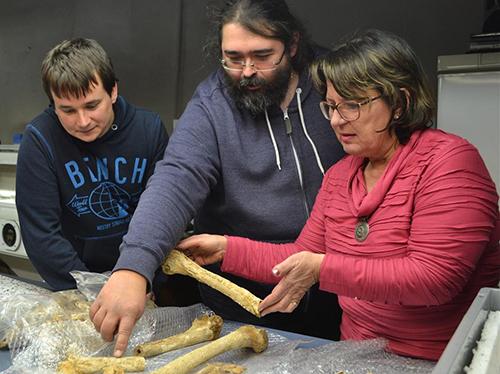Advancements in genetic sequencing continue to enable microbiologists and genetic scientists to explore the origins and mutations of deadly diseases
Microbiologists and researchers can now study the gene sequence of 5,000-year-old bubonic plague bacteria. The scientific team that achieved this feat of gene sequencing believes this is the oldest case of the ancient strain of the plague found to date.
Scientists working at the Institute of Clinical Molecular Biology (IKMB) at the Kiel University and the Centre for Baltic and Scandinavian Archaeology (ZBSA) in Germany, and at the Institute of Latvian History (LVI) at the University of Latvia, recently found remnants of Yersinia Pestis, the infectious bacterium that causes the bubonic plague, in the jawbone of a man who lived more than 5,000 years ago.
For microbiologists, this demonstrates how advances in gene sequencing technologies are allowing scientists to go further back in time to look at how the genomes of bacteria and viruses have evolved and mutated. This helps science understand the process of genetic mutation, as well as learning which mutations survived because they could more easily infect humans.
The scientists published their findings in the peer-reviewed journal Cell Reports, titled, “A 5,000-Year-Old Hunter-Gatherer Already Plagued by Yersinia Pestis
Missing Gene has ‘Dramatic Influence on Virulence’ of Plague
To conduct their study, the researchers sequenced the genomes of samples from the teeth and bones of four hunter-gatherers and tested the remains for bacterial and viral pathogens. They found evidence of Yersinia pestis (Y. pestis) in the dental remains of a 20- to 30-year-old male dubbed RV 2039.
The jaw bones used for the research were discovered in the late 1800s in the Rinnukalns, a stone age settlement unearthed in present-day Republic of Latvia in the late 19th century.
Missing Genetic Element in Ancient Bacterium
The scientists were surprised to find evidence of Y. pestis in the remains and noted that the analysis of the microbe lacked a crucial genetic element observed in later strains of the bacteria. Missing was the gene that allows biting fleas to act as vectors to spread the plague to humans.
“What’s so surprising is that we see already in this early strain more or less the complete genetic set of Y. pestis, and only a few genes are lacking,” said biochemist and archeologist Ben Krause-Kyora, Professor and head of the Ancient DNA (aDNA) Laboratory at the University of Kiel in Germany, and one of the authors of the study, in a press release.
“But even a small shift in genetic settings can have a dramatic influence on virulence,” he added.
This absent gene also is responsible for creating the pus-filled buboes associated with the Black Death (bubonic plague) that occurred in the 1300s. The Black Death killed 75 million to 200 million people worldwide, mostly in Eurasia and North Africa. It is to date the most fatal pandemic recorded in human history.

“Different pathogens and the human genome have always evolved together,” said Professor Ben Krause-Kyora (above left with and Steve Zäuner at center and Dr. Silvia Codreanu-Windauer at right), in the press release. “We know Y. pestis most likely killed half of the European population in a short time frame, so it should have a big impact on the human genome. But even before that, we see major turnover in our immune genes at the end of the Neolithic Age, and it could be that we were seeing a significant change in the pathogen landscape at that time as well,” he added. (Photo copyright: Mittelbayerische.)
A Less Lethal Bubonic Plague?
Although RV 2039 most likely perished from the bubonic plague, the researchers believe his strain of the infection was more mild, less contagious, and not as lethal as the later genetic mutations of the bacteria that caused the Black Death pandemic. The researchers concluded that the man most likely contracted the disease through a bite from an infected rodent or other animal, the press release notes.
“Isolated cases of transmission from animals to people could explain the different social environments where these ancient diseased humans are discovered,” Krause-Kyora said in the press release. “We see it in societies that are herders in the steppe, hunter-gatherers who are fishing, and in farmer communities—totally different social settings but always spontaneous occurrence of Y. pestis cases.”
From Animal Bite to Flea Infection in 7,000 Years’ Worth of Mutations
The Y. pestis bacteria that infected RV 2039, the researchers surmised, most likely split from its predecessor, Yersinia pseudotuberculosis, which first appeared on Earth about 7,000 years ago. It most likely took Y. pestis over a thousand years to acquire all the mutations necessary for flea-based transmission of the bacteria to humans, the researchers noted.
“What’s most astonishing is that we can push back the appearance of Y. pestis 2,000 years farther than previously published studies suggested,” Krause-Kyora said. “It seems that we are really close to the origin of the bacteria.”
It is unknown how many cases still occur worldwide due to unreliable diagnoses and poor reporting in developing countries. However, data from the World Health Organization (WHO) states that there were 3,248 cases of plague reported worldwide between 2010 and 2015, including 584 deaths. Currently, the three most endemic countries for plague are the Democratic Republic of the Congo, Madagascar, and Peru.
The researchers’ findings illustrate how advances in gene sequencing technologies are helping microbiologists, virologists, and genetic scientists understand the affect mutations have on diseases that have plagued humans since the beginning of humanity itself.
Will this lead to new genomic diagnostics? Perhaps. The research is worth watching.
—JP Schlingman
Related Information
What a 5,000-year-old Plague Victim Reveals about the Black Death’s Origins
A 5,000-year-old Hunter-gatherer Already Plagued by Yersinia Pestis
This 5,000-year-old Man had the Earliest Known Strain of Plague
Five Things You Might Not Know about the Plague (Not Including the Fact That it Still Exists)



